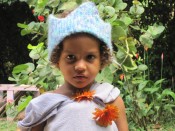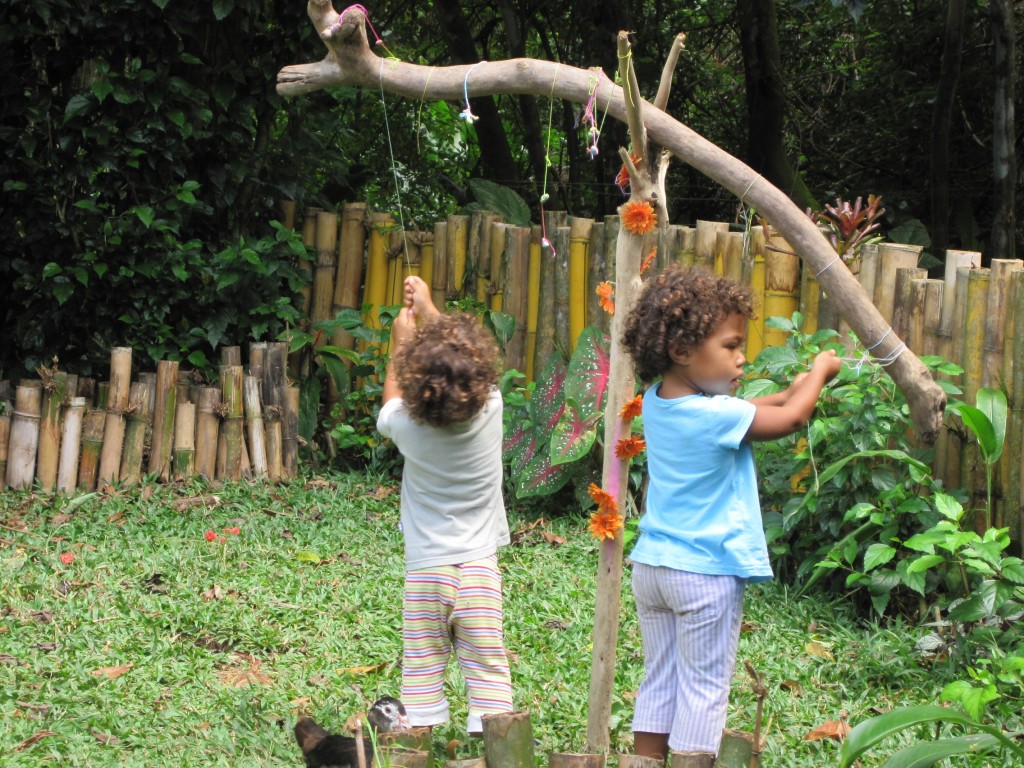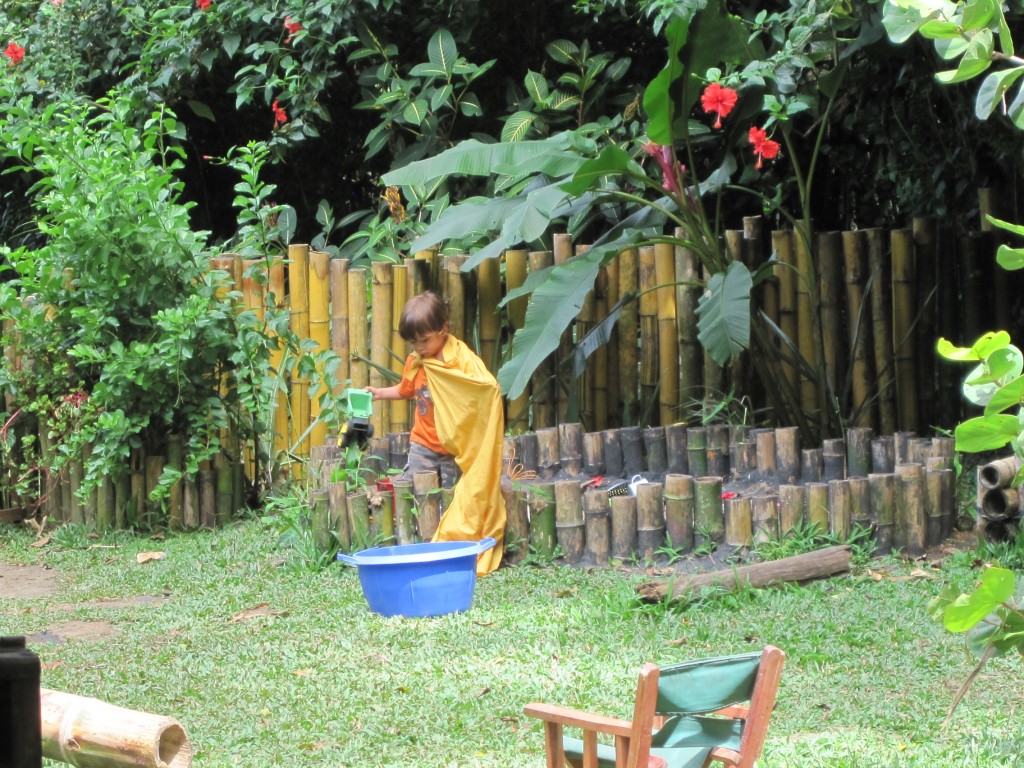Waldorf News
A View from the Tropics: The Sea Heart School in Costa Rica

By Ancel Mitchell
It’s 7:45am and the faculty is just finishing the morning verse and are readying themselves for the day. The classrooms have been swept of leaves and cleaned of any poop from the cane toads that have visited in the night. The chickens are out and the bunnies are in their pens. Fresh hibiscus and ginger flowers are picked for the tables and to put behind an ear or two: the children will bring more. Already it’s hot and humid and the fans are on. There’s a sloth in the beach almond and the sound of howler monkeys is heard in the rainforest that stretches back from the school.
A tropical Waldorf kindergarten setting differs in more than just the ambient noise, though that in itself can be significant. The constant sounds of the ocean, birds, insects, animals and wind in the trees are an ever-present reminder of the life and movement which surrounds us. Nothing stops here. Growth is year round and abundant: the etheric forces are incredibly strong. Leave prunings on the ground and they will sprout, or become a quick home to a colony of termites and a small mushroom farm. Compost piles are ready in a month. Life and death are ever present and it’s not unusual for the smell of death to waft through the gardens or classrooms: the children scan the skies for vultures when their noses pick up the familiar scent. The deep greens of the jungle, the red and orange blaze of the native flowers and the bright blue of the sky and sea are all intensified by the hot glare of the tropical sun; in the rainy seasons the force and energy of the downpours can wash away bridges, trees, beach and roads. The children are all the time bathed in these thick environmental etheric forces.
Our school and the area that we serve is nowhere more than a few hundred yards from the Caribbean Sea , and everywhere backed by low hills covered in rainforest. We are exactly at the meeting place between land and water with the constant pull of the sea and the push of the land. The elementals are vibrant and busy, this is an area that has only recently in the last 100 years become populated, and that scarcely until the last 20 years: it is still very much a wild natural place.
Being 9 degrees north of the equator there is about an hour’s difference in the length of the day throughout the year. At midwinter our day is 11.5 hours long, at midsummer it can be 12.5 hours: the slow breathing in and out of the temperate year doesn’t happen here. Nor do the seasons. We have two wet and two dry times: July and December are wet, March and September are dry and the other months are largely transitional.
 The temperate Waldorf school year with seasons and season-appropriate festivals doesn’t fit well. The festivals ground us while also connecting us to spirit: to feel right and have true meaning they must be rooted in the environment. Michaelmas without a harvest is different, Advent Garden without the chill, quiet evening air and the sense of darkness is scattered and quick. The school year in Central America runs from early February until early December: we stop this year on December 7. It is very strange to end the year – with all the outbreath and excarnation that goes along with it, at just the moment when the world (of the north) is breathing in and preparing for the year’s reflection. It also means that school is not in session for St Nicholas (essentially), Santa Lucia, Advent, Christmas or Three Kings Day. We don’t celebrate those festivals with the children. The last two years we have had an Advent Garden, but we have not found our way into making this festival really live. Missing such a festival rich and deeply ‘warming’ part of the year is important – how do we bring this into our work if not through the active festivals? It’s a question we must continue to work with.
The temperate Waldorf school year with seasons and season-appropriate festivals doesn’t fit well. The festivals ground us while also connecting us to spirit: to feel right and have true meaning they must be rooted in the environment. Michaelmas without a harvest is different, Advent Garden without the chill, quiet evening air and the sense of darkness is scattered and quick. The school year in Central America runs from early February until early December: we stop this year on December 7. It is very strange to end the year – with all the outbreath and excarnation that goes along with it, at just the moment when the world (of the north) is breathing in and preparing for the year’s reflection. It also means that school is not in session for St Nicholas (essentially), Santa Lucia, Advent, Christmas or Three Kings Day. We don’t celebrate those festivals with the children. The last two years we have had an Advent Garden, but we have not found our way into making this festival really live. Missing such a festival rich and deeply ‘warming’ part of the year is important – how do we bring this into our work if not through the active festivals? It’s a question we must continue to work with.
Our ‘seasonal’ year is a blend of festivals and natural events. With no Spring, Summer, Autumn or Winter we look to more subtle changes around us. November and March are full of birds as huge numbers of raptors migrate across our skies. Thousands of hawks, falcons and vultures pass south in November and north in March, rising and gliding on thermal currents. The children run in large spirals with arms outstretched before heading off to far away places in their play. February is a good month for flowers high in the rainforest canopy. June is an amazing month for thunderstorms, and April is busy with spiders which seem to be everywhere. Small changes are important and recognized through story and circle activities: important for marking time in a garden where we can harvest tomatoes, beans, spinach and sweet potato, papaya, coconut and bananas year round.
Our festival year follows the Christian calendar with a few differences.
Easter is an important festival in this officially Catholic country. Here Maundy Thursday and Easter Friday are the holy days. In school we grow papaya and pumpkin seeds in coconut shells and paint eggs. This is our most ‘familiar’ festival.
The Afro-Caribbean population came originally from Jamaica, English was the first language of this area until recently. May Day is still celebrated in some local schools. Our May Day celebration is much like the English celebrations with maypole, flower garlands and games. I think it’s the favorite amongst the parents, many of whom experienced May celebrations as children.
We celebrate Whitsun gently with kindergarten stories, circle activities and dove garlands. The children really seem to resonate with this season and it’s often a beautiful time in the kindergarten and nursery.
St John’s is our fire festival with a bonfire on the beach. Midsummer looks no different from any other day: the solstices and equinoxes are barely noticed. This is another one of our festivals which needs examining: what is the deeper meaning for us here?
 In Costa Rica Independence Day is celebrated on September 15 with a national children’s lantern walk. We have participated in our own way with our own lantern walk at this time. Almost two months ahead of St. Martin’s Day and two weeks before Michaelmas, what do we take of the meaning of St. Martin to bring into this national, and political, holiday? News of Central America’s freedom from Spain was sent south from Mexico by torchbearers bringing and spreading the news, it took four months to reach Costa Rica. Today high school children still run with torches in relays to every community from the Nicaraguan to Panamanian border: it’s quite moving to see these teenagers run together to bring light of freedom and brotherhood with their fellow Central Americans to their communities. This feeling of care for one’s fellow beings and brotherhood that we celebrate with St Martin; the warmth and light in the darkness signifying souls together blends well with this aspect of the traditional lantern walk in September.
In Costa Rica Independence Day is celebrated on September 15 with a national children’s lantern walk. We have participated in our own way with our own lantern walk at this time. Almost two months ahead of St. Martin’s Day and two weeks before Michaelmas, what do we take of the meaning of St. Martin to bring into this national, and political, holiday? News of Central America’s freedom from Spain was sent south from Mexico by torchbearers bringing and spreading the news, it took four months to reach Costa Rica. Today high school children still run with torches in relays to every community from the Nicaraguan to Panamanian border: it’s quite moving to see these teenagers run together to bring light of freedom and brotherhood with their fellow Central Americans to their communities. This feeling of care for one’s fellow beings and brotherhood that we celebrate with St Martin; the warmth and light in the darkness signifying souls together blends well with this aspect of the traditional lantern walk in September.
We celebrate Michaelmas on the beach with wind and water. Two local events have inspired our celebration. The BriBri Indians who are the original inhabitants of this area, never came to the coast except to make salt. They believe that a water demon lives in the sea and swims up rivers to claim lives. (This continues as an active belief, in the recent July storms the demon was blamed for four lives lost through rising rivers.) In late September through October we are visited by the Urania Swallowtail moth, a strikingly beautiful day moth, black in color with brilliant lime green or turquoise blue lightning flash designs across its wings. This moth makes a monumental journey from lowland Pacific El Salvador across the mountainous Continental Divide to our region, and from here continues down through Panama into Columbia. These moths arrive sometimes tattered and torn, having battled winds, mountains, birds, rain, bats to finally find the food they eat on lowland Atlantic Costa Rica. It’s a Michaelic journey that they are driven to make. Our Michaelmas celebration honors the power and strength of wind and water and our relationship to both. We make kites and streamers and tell the story of the child who met the water demon. This year we will harvest salt.
We do have a harvest celebration in late October. Cacao has been an important part of the local culture, economy and community for hundreds of years. The main harvest runs from early October through early December and we celebrate with our own harvesting, fermentation, drying and making chocolate in the middle of the season. In the Americas many of the indigenous peoples believe that man came from corn; the BriBri and their Amazonian ancestors believe that man was created from cacao. We tell the story of that creation while making traditional chocolate. It’s a very happy festival! The cacao fruit is a traditional packed lunch for schoolchildren here, the sweet soft pulp is eaten and the cacao beans themselves, which are very bitter when fresh, are spat out.
Neither King Winter nor Lady Spring have ever visited our nature tables. Our circles and ring times focus more on the elements of water, wind, fire and earth and on traditional occupations.
The heat and humidity mean that our children are rarely layered, coming to school in shorts and tee-shirts with crocs almost everyday of the year. After school they spend afternoons at the beach wearing considerably less. Sunhats are not traditional and in general not worn, shoes are open and loose. Nutrition is also different: we do not give grains at snack as they are too heavy for the climate. Fruit, legumes and roots are used instead and we are always searching for a way to add protein and balance into our meals. The traditional Caribbean diet is very fruit and root rich with oil being used both in cooking and on the skin: we massage the children daily with coconut or aromatic oils.
For all this our largest challenge here is supporting the children’s etheric bodies. Overexposure to the elements, sensory overload, the constant comings and goings associated with living in a tourist town, and lifestyles that revolve around the beach and tourist industry do little to protect the developing child.
We are blessed to have many supportive mentors and visitors: Helle Heckmann, Louise deForest, Joyce Gallardo and Teresa deSavel have visited in the past year, Louise and Helle will be coming again this September, all have been surprised at the overwhelm our children experience.
We have simplified our program, making it as rhythmical and homelike as possible, focusing on caring for our plants, animals, rooms and selves more than doing weekly artistic activities. This caring for our environment helps to balance the overwhelm as we are working with smaller, more manageable pieces and seeing changes in what we are caring for. Daily foot baths, massage with oil and physical care add a layer of protection to a child who spends much of the day nearly naked. It also gives us opportunity to look closely at each child’s skin: fungal and bacterial skin infections here are the most common – and communicable – health issues. Being wrapped in a soft towel or even folded in our long cotton skirts is a much appreciated part of the day.
Life here is simple, much of it spent outdoors in nature, a relaxed (tendency to let things slide) heavy air permeates everything. Holding form, being consistent and consequent is harder in the tropics: partly for the climate and partly for the lack of change on a day to day basis. One knows really that each day there will be sun, waves, insects, coconuts. Holding that center becomes all the more important for our teachers. Our faculty meetings, study and maintaining our property help ground us.
During the day our children might disturb a colony of bats while helping harvest bananas, or they might finally catch the big crab who lives beneath the octopus palm. Someone will be bitten by an ant, and someone will remove their clothes. We will gather eggs, rake leaves, fetch sweet potato vines for the rabbits and sweep the spiders out of our bathrooms. The older children will make tortillas while others gather wood for our new biochar stove. There will be water play and sand play and laughter. And tomorrow we will repeat.
Sea Heart School is a small Waldorf Initiative in Costa Rica. In our third year we serve 24 children from 18 months to 6 years. We will be opening a Parent Child Group later this year and host several workshops on many aspects of child development and community life for our local community of Puerto Viejo.
Our beautiful schoolhouse and garden are for sale. We are trying to raise money to buy our site and allow us to flourish in a permanent home. If anyone might be interested in purchasing a lovely two bedroom house that is empty for up to 3 months of the year, filled with love and good energy and 200 yards to the beach, please contact us, or see our website for details!!! www.seaheartschool.blogspot.com
 Transforming Voices Worldwide
Transforming Voices Worldwide Everything a Teacher Needs
Everything a Teacher Needs Middle School Science With Roberto Trostli
Middle School Science With Roberto Trostli Jamie York Books, Resources, Workshops
Jamie York Books, Resources, Workshops
 Bay Area Teacher Training
Bay Area Teacher Training ~ Ensoul Your World With Color ~
~ Ensoul Your World With Color ~ Association for a Healing Education
Association for a Healing Education Waldorf-inspired Homeschool Curriculum
Waldorf-inspired Homeschool Curriculum Quality Education in the Heartland
Quality Education in the Heartland Roadmap to Literacy Books & Courses
Roadmap to Literacy Books & Courses Space speaks. Its language is movement.
Space speaks. Its language is movement. Caring for All Stages of Life
Caring for All Stages of Life Bringing Love to Learning for a Lifetime
Bringing Love to Learning for a Lifetime Waldorf Training in Australia
Waldorf Training in Australia Summer Programs - Culminating Class Trips
Summer Programs - Culminating Class Trips Great books for Waldorf Teachers & Families
Great books for Waldorf Teachers & Families Apply Today: New Cohort Starts Nov. 2025
Apply Today: New Cohort Starts Nov. 2025 Flexible preparation for your new grade
Flexible preparation for your new grade Immersive Academics and Arts
Immersive Academics and Arts The Journey is Everything
The Journey is Everything Full-Time Teacher Education
Full-Time Teacher Education Train to Teach in Seattle
Train to Teach in Seattle RSS Feeds
RSS Feeds